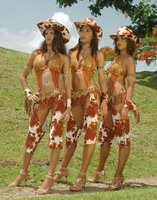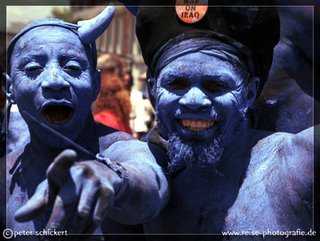What is carnival???It is an annual celebration of life found in many countries of the world. And in fact, by learning more about carnival we can learn more about ourselves and a lot about accepting and understanding other cultures.
Where did the word “carnival” come from?Hundred and hundreds of years ago, the followers of the Catholic religion in
Italy (VIVA ITALIA!!!! - those are my roots, explains a bit why I am a nut about TnT Carnival)started the tradition of holding a wild costume festival right before the first day of Lent. Because Catholics are not supposed to eat meat during Lent, they called their festival, carnevale — which means “to put away the meat.” As time passed, carnivals in Italy became quite famous; and in fact the practice spread to France, Spain, and all the Catholic countries in Europe. Then as the French, Spanish, and Portuguese began to take control of the Americas and other parts of the world, they brought with them their tradition of celebrating carnival.
African influences on carnival traditionsImportant to Caribbean festival arts are the ancient African traditions of parading and moving in circles through villages in costumes and masks. Circling villages was believed to bring good fortune, to heal problems, and chill out angry relatives who had died and passed into the next world. Carnival traditions also borrow from the African tradition of putting together natural objects (bones, grasses, beads, shells, fabric) to create a piece of sculpture, a mask, or costume — with each object or combination of objects representing a certain idea or spiritual force.
Feathers were frequently used by Africans in their motherland on masks and headdresses as a symbol of our ability as humans to rise above problems, pains, heartbreaks, illness — to travel to another world to be reborn and to grow spiritually. Today, we see feathers used in many, many forms in creating carnival costumes.
African dance and music traditions transformed the early carnival celebrations in the Americas, as African drum rhythms, large puppets, stick fighters, and stilt dancers began to make their appearances in the carnival festivities.
In many parts of the world, where Catholic Europeans set up colonies and entered into the slave trade, carnival took root. Brazil, once a Portuguese colony, is famous for its carnival, as is Mardi Gras in Louisiana (where African-Americans mixed with French settlers and Native Americans). Carnival celebrations are now found throughout the Caribbean in Barbados, Jamaica, Grenada, Dominica, Haiti, Cuba, St. Thomas, St. Marten; in Central and South America in Belize, Panama, Brazil; and in large cities in Canada and the U.S. where Caribbean people have settled, including Brooklyn, Miami, and Toronto. Even San Francisco has a carnival!
Carnival in Trinidad and Tobago (THE MOTHER OF CARNIVALS!!!!!)Trinidad's carnival is a beautiful example of how carnival can unite the world. For in this small nation, the beliefs and traditions of many cultures have come together; and for a brief five days each year, the whole country forgets their differences to celebrate life!
Like many other nations under colonial rule, the history of Native Americans and African people in Trinidad is a brutal, sad story. Spain and England at different times both claimed Trinidad as their colonies. Under British rule, the French settled in Trinidad, bringing with them their slaves, customs, and culture. By 1797, 14,000 French settlers came to live in Trinidad, consisting of about 2,000 whites and 12,000 slaves. Most of the native peoples (often called the Amerindians) who were the first people to live in Trinidad, died from forced labor and illness.
Carnival was introduced to Trinidad around 1785, as the French settlers began to arrive. The tradition caught on quickly, and fancy balls were held where the wealthy planters put on masks, wigs, and beautiful dresses and danced long into the night. The use of masks had special meaning for the slaves, because for many African peoples, masking is widely used in their rituals for the dead. Obviously banned from the masked balls of the French, the slaves would hold their own little carnivals in their backyards — using their own rituals and folklore, but also imitating their masters’ behavior at the masked balls.
For African people, carnival became a way to express their power as individuals, as well as their rich cultural traditions. After 1838 (when slavery was abolished), the freed Africans began to host their own carnival celebrations in the streets that grew more and more elaborate, and soon became more popular than the balls.
Today, carnival in Trinidad is like a mirror that reflects the faces the many immigrants who have come to this island nation from Europe, Africa, India, and China. African, Asian, and American Indian influences have been particularly strong.
Carnival is such an important aspect of life in Trinidad that many schools believe that sponsoring a carnival band is a way to teach young people about their roots and culture. In Trinidad’s Kiddies Carnival, hundreds of schools and community organizations participate! In this way, communities work together to develop stronger friendships and greater respect for the many cultures that make up Trinidad.



